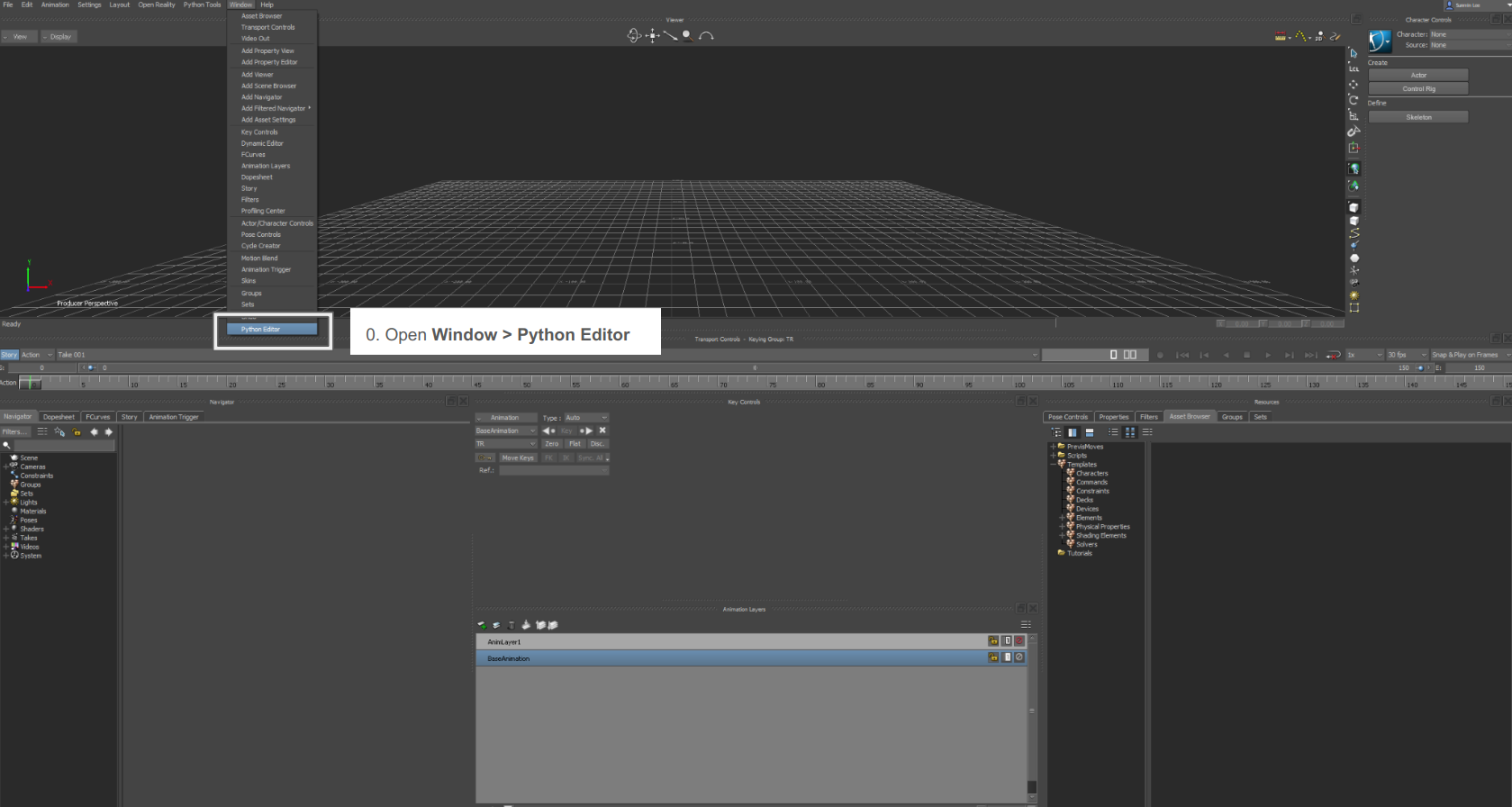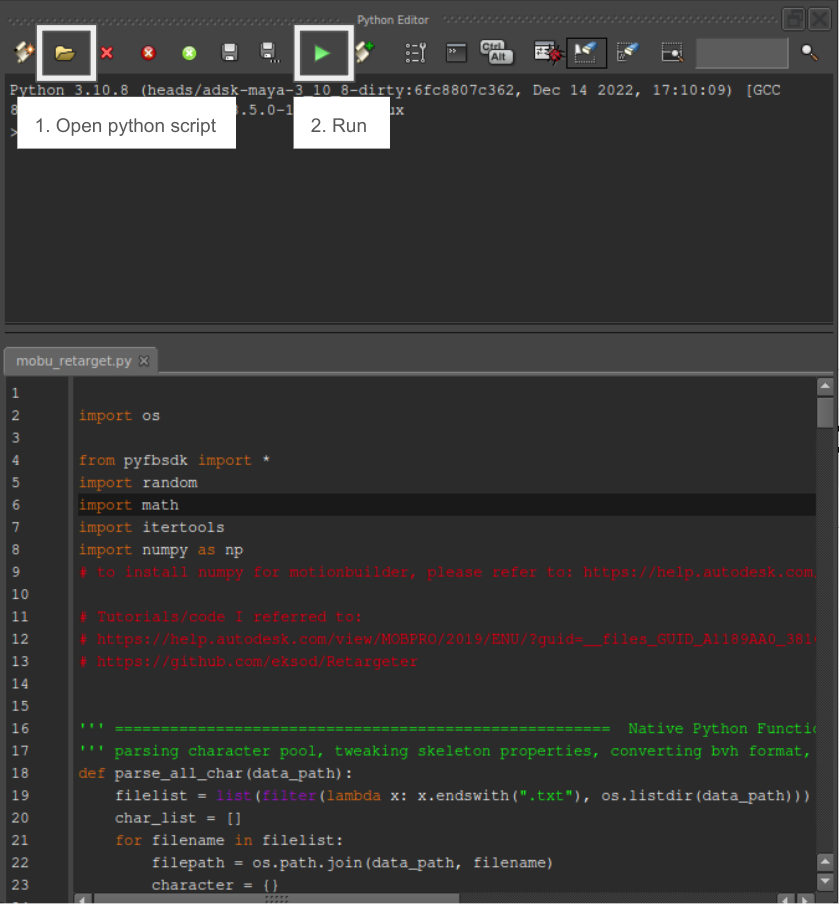Authors' implementation of the paper SAME: Skeleton-Agnostic Motion Embedding for Character Animation (SIGGRAPH ASIA 2023 Conference Proceedings).
Project Page | ACM Library | Paper | Video
- Install freeglut3-dev :
sudo apt-get install freeglut3-dev. - Set up a virtual environment.
cd SAME conda create -n same python=3.8 conda activate same - Python dependencies can be installed at once by running the script:
We checked our code works with Python 3.8, pytorch 2.3.0 and CUDA 11.8. You may modify library versions if needed.
bash ./install.sh
The installation script also includes initializing our forked version of fairmotion.
- We provide a pretrained model
result/ckpt0. - You can download the dataset all at once, or per individual task if you're interested specifically in certain tasks.
=== Viewer Control ===
Mouse
Left Rotate
Right Pan
Middle Zoom
Keyboard
space play/stop
[ previous frame
] next frame
m next result
All commands in this README assume you are running them under the src directory.
-
SAME Autoencoder:
-
Qualitative Evaluation:
python same/test.py- Given a source motion (left) and a random target skeleton (middle), retargeted result (right).
- Source and target skeleton are masked (some joints are removed) randomly.
-
Quantitative Evaluation (Table 1,2):
python task/evaluation/table1.py python task/evaluation/table2.py
-
-
Downstream Tasks
-
Arithmetic Operation:
python task/arithmetic/main.py- Given motions
M_b, M_p, M_m(Left three motions) which may have different skeletons and a scales, we demonstrate arithmetic operation in SAME spaceZ_b + s * (Z_p - Z_m)realized to a random character(Rightmost). Press[m]to see next result.
- Given motions
-
Similar Motion Search:
python task/similar_motion_search/main.py- For each motion in Key set, it searches the top 5 closest motion among search database.
- The search result and the distance between the key and the searched result is printed and also saved to
search_result.csv.
-
Motion Classification:
python task/classification/main.py- It trains a skeleton-agnostic motion classifier. At each epoch, it prints the test accuracy and fail cases.
-
Motion Matching:
python task/motion_control/main.py- Run motion matching in SAME-space according to auto-generated user control input.
- To try morphing the character on the fly as in the demo video, add the
--demo skel_changeargument. Character morphing will occur about 16 seconds after starting.
-
This section describes the full process to train and test your own model:
- Data preprocess: Prepare dataset and create augmented motion pairs
- Base model : Train a Skeleton-Agnostic Motion Autoencoder
- Downstream tasks
Let's walk through each step.
We provide a training dataset we used in the paper. If you want to use this dataset for training your model, you may skip this step, and proceed to Step 2.
If you have your own dataset that you want to use for training, please follow the steps below.
For a more detailed explanation of the notations and algorithms, please refer to Section 4.3.1 and Appendix Algorithms 1 and 2 of our paper.
-
Skeleton dataset
$S$ -
Place skeleton T-pose bvhs under
data/[DATA_NAME]/character/bvh/.Example File Hierarchy
data └── sample └── character └── bvh └── s0.bvh └── s1.bvh └── ...
-
Extract character's joint global position at its T-pose.
The result is saved underdata/[DATA_NAME]/character/joint_pos/as the same filename in.txtfile extension.python preprocess/skel_list.py --data [DATA_NAME] # example) python preprocess/skel_list.py --data sampleExample File Hierarchy
data └── sample └── character └── bvh └── s0.bvh └── s1.bvh └── ... └── joint_pos └── s0.txt └── s1.txt └── ...
-
-
Motion dataset
$M$ -
Place motion bvh files under
data/[DATA_NAME]/motion/bvh/. It's fine to include a subdirectory.Example File Hierarchy
data └── sample └── motion └── bvh └── m0.bvh └── m1.bvh └── ... └── subdir └── m2.bvh └── m3.bvh └── ...
-
The first frame of motion should be in T-pose with the character facing +Z axis positioned at the origin(0,0) of XZ plane.
-
If the motion is too long, we cut our motions into reasonable length (e.g., 10 seconds) to balance the motion length with other short motion clips. This step is optional.
-
Here we explain how to augment Skeleton dataset
-
Install Autodesk MotionBuilder. Autodesk supports education license for students.
-
Modify the following settings in
mobu_script/mobu_retarget.py- specify
DATA_DIR,DATA_NAME -
batch_size: motion batch size to retarget per each random skeleton ($B$ in algorithm 2.) -
iter_num: number of retargeting iteration ($R$ in algorithm 2.) -
merge_skel: whether to use a single target skeleton (True if not using any skeletal variations) -
fresh_start: in case you stopped retargeting script and wish to continue from where you stopped (rather than retargeting all over again), setfresh_start= False.
Otherwise use True as default. - If bvh files contains joint names that are not included in Mobu joint names, add it to
joint_candidates. Please refer to the code comments for more detail. - We removed finger joints from all data. If you want to include finger joints and retarget them, you may modify the
jointListandjoint_candidatesproperly to characterize and retarget fingers as well.
- specify
-
Start MotionBuilder
-
From Window > python editor, open and run the python script (
mobu_script/mobu_retarget.py).-
The result is generated under
data/[DATA_NAME]/motion/.-
result: retargeted motions (filenames: 0.bvh, 1.bvh, ...) - Additionally,
character.txt,fileList.txt,pair.txtare generated.
For the detail of the information each file contains, please refer tomobu_retarget.py - Caution: Motionbuilder may crash if you try to mainpulate the UI while running the script. It's better to leave it do its job and wait... If it crashed in the middle, we have continue options (
fresh_start=False) so that you don't have to re-start all over again.
Example File Hierarchy after augmenting
data └── sample └── motion └── bvh └── m0.bvh └── m1.bvh └── ... └── subdir └── m2.bvh └── m3.bvh └── ... └── result └── retarget_0.bvh └── retarget_1.bvh └── ... └── character.txt └── filelist.txt └── pair.txt -
-
Process a paired motion dataset(.bvh files) to .npz files.
python preprocess/preprocess_data.py --data [DATA_NAME]
--train : when processing a training dataset.
If you turn on the flag, mean/std statistics of data are computed and saved.
(For the test dataset, turn this off so the statistics won't be computed.
Statistics from the training dataset will be used automatically during inference.)
--wopair : when using a dataset without augmented pairs (i.e., w/o pair.txt).
--append_log: when continuing the process (killed unexpectedly) or when merging multiple dataset.
example result file hierarchy after running python preprocess/preprocess_data.py --data sample --train
data
├── sample
│ └── motion
│ └── bvh
│ └── m0.bvh
│ └── m1.bvh
│ └── ...
│ └── subdir
│ └── m2.bvh
│ └── m3.bvh
│ └── ...
│ └── result
│ └── retarget_0.bvh
│ └── retarget_1.bvh
│ └── ...
| └── pair.txt
│ └── processed
│ └── m0.bvh.npz
│ └── m1.bvh.npz
│ └── subdir
│ └── m2.bvh.npz
│ └── m3.bvh.npz
│ └── ...
│ └── result
│ └── retarget_0.bvh.npz
│ └── retarget_1.bvh.npz
│ └── ...```
| └── ms_dict.pt
Create a config file (e.g., config/mycfg.yml) and specify train_data as the dataset you created from Step 1.
# train
python same/train.py --config [CFG_NAME] --exp [EXP_NAME]
# Make sure you preprocessed test dataset following Step 1.3 as well.
python same/test.py
--model_epoch [model_name]: one of the format [EXP_NAME], [EXP_NAME]/[saved_epoch(int)], or [EXP_NAME]/latest
--data_dir [DATA_NAME]
--device cpu or cuda
--rnd_tgt use random target skeleton (else; select target skeleton from the paired dataset)
--src_mask randomly mask part of the src skeleton joints (prob=0.5)
--tgt_mask randomly mask part of the tgt skeleton joints (prob=0.5)
Given motions M_b, M_p, M_m and a scale s which may have different skeletons,
we demonstrate arithmetic operation in SAME space Z_b + s * (Z_p - Z_m) realized to a random character.
Specify [data_dir], [m_plus], [m_minus] of the motion dataset you want to use and [scale] properly.
python task/arithmetic/main.py
--model_epoch [model_epoch]
--device [cpu or cuda]
--m_plus [M_p bvh file path]
--m_minus [M_m bvh file path]
--scale [scale (float)]
--data_dir [data directory that contains M_b]
We can find similar motions given key and search database that consists of different skeletons.
Top 5 search results and the distance are printed and saved to search_result.csv
python task/similar_motion_search/main.py
--model_epoch [model_epoch]
--key_set [key data directory]
--search_set [search database directory]
To train a Skeleton-Agnostic motion classifier, prepare a labeled motion dataset (data_dir).
At each epoch, test accuracy and fail cases are printed. Trained model is saved under out.
python task/classification/main.py
--model_epoch [model_epoch]
--data_dir [data directory of which a subdirectory('train', 'validate') contains bvh files]
--out [directory name to save the learned classifier]
Example Data File Hierarchy
data
└── [data_dir]
└── train
└── bvh
└── label0 (e.g., walk)
└── motion0.bvh
└── ...
└── label1 (e.g., jump)
└── motion1.bvh
└── ...
└── ...
└── validate
└── bvh
└── label0 (e.g., walk)
└── testmotion0.bvh
└── ...
└── label1 (e.g., jump)
└── testmotion1.bvh
└── ...
└── ...
For SAME-space motion matching among heterogeneous datasets,
Collect the motion dataset you want to use and annotate action labels (data_dir).
task/motion_control/main.py
--model_epoch [model_epoch]
--data_dir [data_dir]
*Note: There are also many parameters you can choose for motion matching;
you may tune according to the motion dataset, control logic, and your taste for performance.
Example Data File Hierarchy
[data_dir]
└── motion
└── m1.bvh
└── m2.bvh
└── ...
└── annotation
└── m1.lab
└── m2.lab
└── ...
This project stands on the shoulders of several open-sourced libraries and prior research.
- We were inspired by deep-motion-editing in representing skeletal motion as a graph and employing GNN.
- Our code builds upon fairmotion which offers motion library and visualization capabilities.
- Our MotionBuilder python scripting is largely based on Retargeter.
- We adopted spring functions, foot sliding cleanup, trajectory prediction, and some controller logic from Motion-Matching.
We sincerely thank the authors for sharing their amazing work.
We hope our open-source efforts can contribute similarly.
If you find our work useful, please cite our paper:
@article{10.1145/3610548.3618206
author = {Lee, Sunmin and Kang, Taeho and Park, Jungnam and Lee, Jehee and Won, Jungdam},
title = {SAME: Skeleton-Agnostic Motion Embedding for Character Animation},
year = {2023},
doi = {10.1145/3610548.3618206},
booktitle = {SIGGRAPH Asia 2023 Conference Papers},
location = {Sydney, NSW, Australia},
}
Sunmin Lee sunmin.lee@imo.snu.ac.kr






